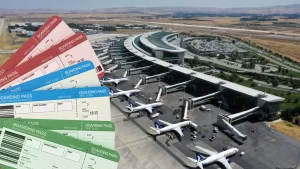Guide to Finding Cheap Flight Tickets

How to Find Cheap Flights: A Comprehensive Guide for Travelers
Finding affordable flights is the cornerstone of budget-friendly travel. With the right strategies and tools, finding the cheapest flight is entirely possible. This comprehensive guide will cover various methods, tips, and tricks to help you navigate the complex world of flight booking and achieve significant savings on your next adventure.
- The Golden Rule: When Should You Book Your Flight?
- General Booking Window:
- Key Factors to Consider:
- Finding the Optimal Booking Window
- The Cheapest Months to Fly
- Harnessing the Power of Flight Comparison Engines (Skyscanner, Google Flights, Momondo)
- The Power of Flexibility:
- Setting Price Alerts:
- The Incognito Trick:
- The VPN Advantage:
- The Hidden City Ticketing Strategy (and its risks)
- One-Way vs. Round-Trip:
- Budget Airlines:
- Frequent Flyer Programs and Loyalty Points
- Considering Alternate Airports
From understanding the best booking times to leveraging advanced search techniques, we’ll cover everything you need to become a knowledgeable flight finder.
The Golden Rule: When Should You Book Your Flight?

One of the most frequently asked questions when planning a trip is, “When is the best time to book a flight?” While the answer isn’t always simple and a perfect, one-size-fits-all formula doesn’t exist, understanding current market dynamics, historical data, and maintaining a bit of flexibility are the keys to securing the best deal.
The old adage of booking exactly 42 days in advance or on a specific Tuesday is largely outdated. Today’s airline pricing is driven by complex algorithms and real-time demand, making the “best time” a moving target. However, by analyzing trends, we can identify reliable guidelines.
General Booking Window:
If you have domestic flights planned, the best booking window for travel within your own country is generally 1 to 3 months in advance. Prices typically start to increase significantly within 3 weeks.
For international flights (travel abroad), you should generally start looking further ahead. The best time is usually 2 to 5 months before departure. This gives you time to monitor prices and find a good deal.
Key Factors to Consider:
Booking too early (more than 6 months in advance) can sometimes mean higher prices for planners with inflexible schedules. Booking too late (less than 3 weeks for domestic flights and 6 weeks for international flights) almost always means paying extra. The goal is to find the “just right” window in the middle.
Seasonality and demand are arguably the most important factors. Traveling during peak seasons (summer holidays, Christmas, New Year’s Eve, major events) will always be expensive. You should book much earlier for these periods, typically 4-6 months in advance, because prices will constantly increase.
While there’s no magic bullet for choosing a specific day of the week to book, historical data shows that airlines often launch discounts on Tuesday afternoons and Wednesdays to match competitors’ prices from the previous weekend. This is a good day to check and book.
If your travel dates are flexible, even by a day or two, use the “flexible dates” search feature on flight comparison sites (like Google Flights, Kayak, or Skyscanner). This can save you hundreds of dollars.
Setting up price alert notifications is your most powerful tool. Once you have a route and approximate dates in mind, set up price alerts on various platforms. These alerts will notify you when prices drop, allowing you to book with confidence.

Is Booking Early Always Cheaper?
Contrary to popular belief, booking your flight months in advance doesn’t always guarantee the lowest price. While booking early can guarantee a seat, airlines often adjust their prices based on demand, competitor pricing, and remaining capacity. There are times when prices drop closer to departure, especially when the airline needs to fill unsold seats. However, this is a gamble, and last-minute bookings can often be significantly more expensive. The key is to strike a balance between booking too early and too late.
The Sweet Spot:
Finding the Optimal Booking Window
Research suggests that there’s an optimal booking window for domestic and international
flights. For domestic flights, this window typically falls between weeks and months
before departure. For international flights, it’s generally advisable to book between to
months in advance. These periods often represent the sweet spot where airlines have
released a good portion of their inventory, and demand hasn’t yet driven prices sky-high.
However, these are general guidelines, and prices can fluctuate based on specific routes,
airlines, and travel seasons.
Leveraging Seasonality:
The Cheapest Months to Fly
Understanding seasonality is crucial for finding cheap flights. Prices tend to surge during
peak travel seasons, such as summer holidays, Christmas, New Year, and major festivals.
Master the Art of Searching:
Tools and Techniques The digital age has blessed travelers with a plethora of tools designed to simplify the flight search process. Leveraging these effectively can make a significant difference in finding the best deals.
Harnessing the Power of Flight Comparison Engines (Skyscanner, Google Flights, Momondo)
Flight comparison websites are your best friends when hunting for cheap flights. Instead of checking individual airline websites, these platforms aggregate prices from hundreds of airlines and online travel agencies, presenting them in a single, easy-to-compare format. Popular options include Skyscanner, Google Flights, and Momondo. Each platform has its unique strengths. For instance, Google Flights is known for its price tracking and emission information, while Skyscanner is praised for its flexible search options and price alerts. It’s often beneficial to check multiple comparison sites, as some might display deals that others miss. Always cross-reference prices with the airline’s official website before booking, as sometimes direct bookings can be cheaper, or vice-versa.
The Power of Flexibility:
Using “Explore Everywhere” and Flexible Date Features Flexibility is a superpower in the world of cheap flights. If your travel dates or destination are not set in stone, you can unlock incredible savings. Tools like Skyscanner’s “Everywhere” search feature allow you to see the cheapest destinations from your departure city, which is perfect for spontaneous travelers. Similarly, using flexible date options on comparison sites enables you to view price trends across an entire month or even year, highlighting the cheapest days to fly. This can reveal significant price differences for just a few days’ shift in your travel plans.
Setting Price Alerts:
Let the Deals Come to You Constantly checking flight prices can be time-consuming. Price alerts solve this problem by notifying you when the fare for a specific route drops. Most flight comparison engines, including Google Flights and Skyscanner, offer this feature. By setting up an alert, you can sit back and wait for the perfect deal to land in your inbox, ensuring you don’t miss out on potential savings.
Think Outside the Box: Advanced Strategies for Savvy Travelers
Beyond the basic search techniques, there are several advanced strategies that experienced travelers use to snag exceptionally low fares.
The Incognito Trick:
Clearing Cookies and Using Private Browsing Have you ever noticed that flight prices seem to increase after you’ve searched for them multiple times? This isn’t a coincidence. Travel websites often use cookies to track your browsing behavior. If they detect repeated searches for the same route, they might subtly increase prices, assuming you’re highly interested and willing to pay more. To circumvent this, always search for flights in incognito or private browsing mode. This prevents websites from storing cookies and ensures you see the true, unfiltered prices. Alternatively, you can clear your browser’s cookies and cache before each search.
The VPN Advantage:
How Your Location Affects Prices Flight prices can vary significantly based on the country from which you are searching. Airlines and online travel agencies sometimes offer different fares to customers in different geographical locations. By using a Virtual Private Network (VPN), you can mask your actual IP address and make it appear as if you are browsing from another country. Experiment with different server locations to see if you can find a cheaper fare for the same flight. This strategy requires a bit of trial and error but can lead to substantial savings, especially for international routes
The Hidden City Ticketing Strategy (and its risks)
Hidden city ticketing, also known as throwaway ticketing, involves booking a flight with a layover in your desired destination, but then disembarking at the layover city and not completing the final leg of the journey. For example, if you want to fly from City A to City B, but a flight from City A to City C with a layover in City B is cheaper, you would book the A-C flight and simply get off at B. While this can sometimes result in significant savings, it comes with considerable risks. Airlines generally prohibit this practice, and if caught, you could face penalties such as losing your frequent flyer miles, having your ticket canceled, or even being charged the difference in fare. It is also not advisable if you have checked baggage, as your luggage will likely be routed to the final destination on your ticket. Use this strategy with extreme caution and only for one-way flights with carry-on luggage.
One-Way vs. Round-Trip:
Sometimes Two is Cheaper Than One It might seem counterintuitive, but sometimes booking two separate one-way tickets can be cheaper than a single round-trip ticket. This is especially true when dealing with different airlines or when one leg of your journey is significantly more expensive than the other. Always compare the cost of a round-trip ticket with the combined cost of two oneway tickets to see which option offers better value. This flexibility also allows you to mix and match airlines, potentially leading to better flight times or more convenient connection.
Beyond the Search Engine:
Other Factors to Consider While search engines are powerful tools, several other factors can influence the final cost of your flight and your overall travel experience.
Budget Airlines:
Pros and Cons Budget airlines, also known as low-cost carriers, are renowned for their incredibly low base fares. They achieve this by unbundling services and charging extra for everything from checked baggage and seat selection to in-flight meals and priority boarding. While they can be a fantastic option for short-haul flights or when you’re traveling light, it’s crucial to factor in all potential additional costs before booking. Sometimes, a full-service airline with a slightly higher base fare might end up being cheaper once all the extras are added. Always read the fine print and understand what’s included (and what’s not) in your budget airline ticket.
Frequent Flyer Programs and Loyalty Points
If you travel frequently, joining airline frequent flyer programs can lead to significant savings over time. These programs reward loyal customers with points or miles that can be redeemed for free flights, upgrades, or other travel perks. Even if you don’t fly often, many airlines have partnerships with credit card companies, allowing you to earn miles on everyday purchases. Accumulating and strategically using these points can drastically reduce your out-of-pocket flight expenses.
Considering Alternate Airports
Major cities often have multiple airports, and the cost of flying into or out of each can vary significantly. For example, flying into a smaller, regional airport near your destination might be cheaper than landing at the main international hub. While this might require a bit more planning for ground transportation, the savings on airfare can often outweigh the inconvenience. Always check prices for all nearby airports when searching for flights.
Final Checklist Before You Book
Before you hit that ‘book now’ button, take a moment to review these crucial points to ensure a smooth and cost-effective journey. Double-Check Baggage Fees and Extras One of the most common pitfalls for travelers seeking cheap flights is overlooking baggage fees. Many budget airlines, and even some full-service carriers on their basic economy fares, charge extra for checked luggage and sometimes even for carry-on bags. Before finalizing your booking, always check the airline’s baggage policy and factor in any potential fees. This will give you a true understanding of the total cost of your ticket and help you avoid unpleasant surprises at the airport. Read the Fine Print: Cancellation Policies and Flexibility Life happens, and sometimes travel plans change. Before booking, familiarize yourself with the airline’s cancellation and change policies. While cheaper tickets often come with stricter rules and higher fees for modifications, some airlines offer more flexible options for an additional cost. Consider whether the added flexibility is worth the price, especially if your travel dates are uncertain. Understanding these policies upfront can save you a lot of headaches and money in the long run.

Confirming Your Booking Directly with the Airline
After booking through a third-party comparison site or online travel agency, it’s always a good practice to confirm your reservation directly with the airline. Visit the airline’s official website, enter your booking reference number (PNR), and verify that all your details are correct. This ensures that your booking is properly registered with the airline and allows you to manage your reservation, select seats, or make any necessary changes directly. It also provides peace of mind, knowing that your flight is confirmed and ready for your journey. By following these comprehensive strategies and tips, you’ll be well-equipped to find and book cheap flights, making your travel dreams a more affordable reality. Happy travels!




